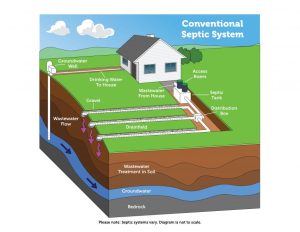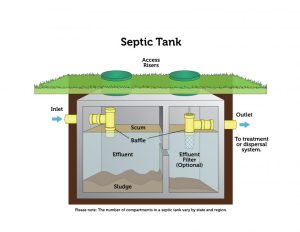
Wastewater is the “used” water that flows out of homes and businesses through washing machines, toilets, sinks, and tubs. It includes everything carried in that water – soap, grease, hair, feces, toilet paper – as it leaves the building through drainpipes. Since water is too precious to waste, it enters a wastewater management system that eventually returns it to the environment for reuse. That system may be a septic tank and leach field on the home’s property, or it may be a water treatment plant serving the area.
It matters what we put into drainpipes. Treating sinks and toilets like trashcans can clog up the system and cause wastewater to back up into the building – and that will ruin your day, at a minimum. Fats, oils, and grease (FOG) can cling to drainpipes and slow or stop water drainage. Baby wipes, plastic gloves, and most types of trash are not biodegradable; they fill up septic tanks and can clog drainpipes and drainage lines.
How Wastewater Management Systems Work
On-site wastewater management relies on four systems: plumbing, septic tank, drainage lines, and leach field. Household plumbing moves wastewater into the tank. There, solid material settles into a sludge layer at the bottom, oils float up to create a scum layer, and partially clarified wastewater stands in between. Bacteria and other microbes digest organic waste and reduce its volume. As additional wastewater enters the tank, clarified wastewater flows out to the system of drainage lines installed underground throughout the leach field. Perforations in these lines allow wastewater to seep into the soil, where soil particles and microbes provide another level of cleansing. Wastewater percolates through soil layers and returns to groundwater.

Maintenance for On-Site Wastewater Systems
Microbes that digest organic waste are naturally present in the waste, so additives are not necessary or helpful. Because microbial digestion doesn’t completely remove waste, built-up solids need to be pumped out of the septic tank every few years. Task 1 is locating the septic tank so it can be serviced.

One location clue is the clean-out pipe, a 4-inch diameter PVC pipe, sticking up a foot or so from a slab foundation. The tank is usually 5-10 feet away from this pipe. In homes with an unfinished basement or crawl space, the point where wastewater pipes join and exit the building probably points the way to the septic tank. Another option is to contact the county Environmental Health Department to request a copy of the sketch showing the system’s location on the property. If all else fails, hire a state certified septic system contractor to conduct a search.
The leach field also needs care to keep it functioning properly. Look for an area where the grass looks greener or the soil seems to stay moist. Avoid planting into and/or parking on the leach field as both activities can damage drainage lines and interfere with the soil’s ability to drain away outflowing wastewater. In rainy conditions, reduce household water usage. Saturated soil may not be able to drain additional water from showers or multiple laundry loads.
With care and routine maintenance, septic systems can function for decades. For more information, see UGA Extension Bulletin 1421, A Beginner’s Guide to Septic Systems.